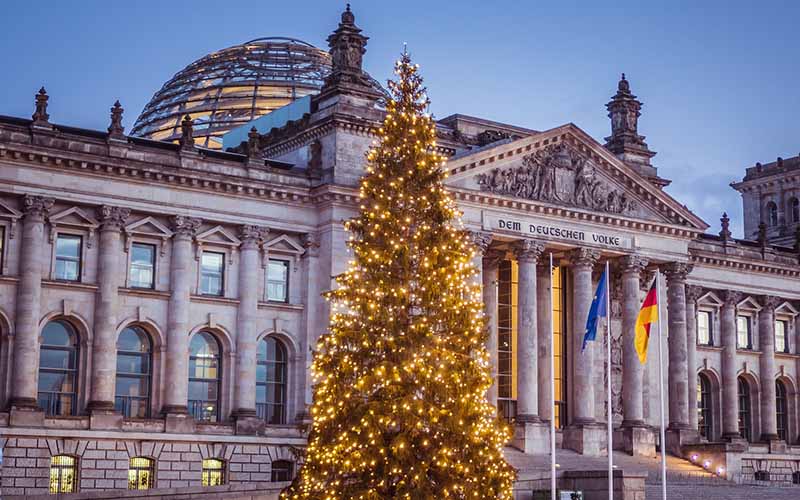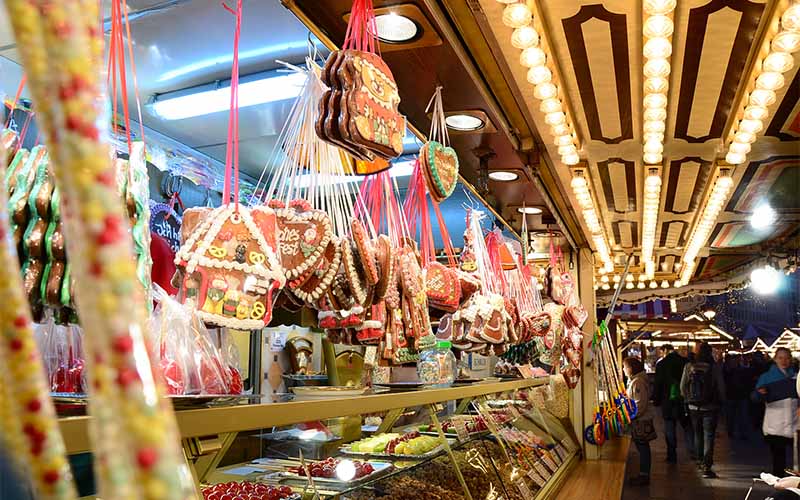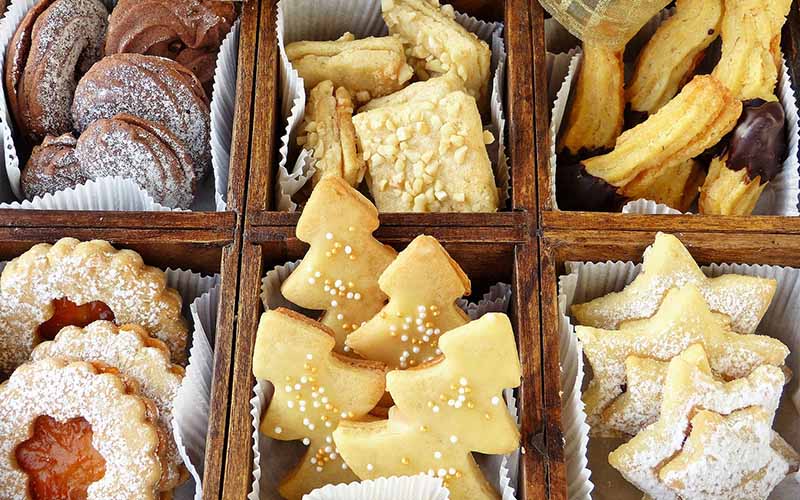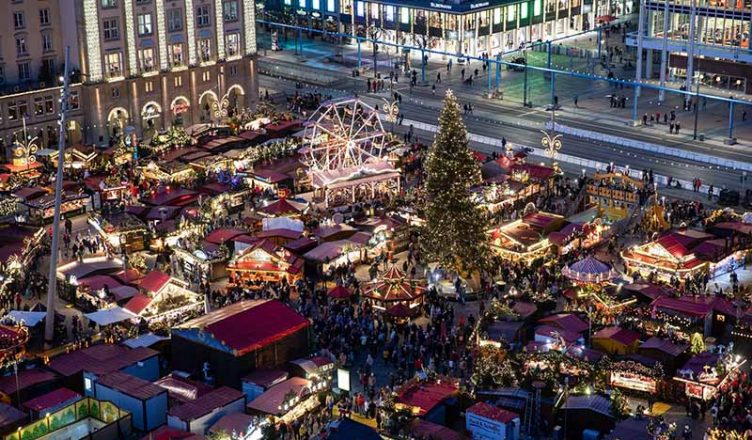December in Germany is the perfect month to experience the region’s age-old Christmas traditions that are still alive. As Christmas arrives, life slows down, and the entire country dives into the festive mood. Christmas in Germany is a magical time celebrated with many traditions unique to the country. It starts from the Advent celebrations in Mid-November, when people start enveloping themselves in their homes in wintery magic, baking together, playing together, or simply spending time with each other.
Germany Christmas celebrations begin on December 24th, on Christmas Eve (Heiliger Abend), when Christmas gifts are exchanged. It is the last day of Advent or “’holy evening’” when offices and businesses close by afternoon. On 25th December (first celebration), also known as “’Erster Feiertag’” and 26th December (second celebration), known as “’Zweiter Feiertag’”, families gather together, home-cooked food is eaten and people enjoy well-deserved time off work. During this time, many cities and towns hold Christmas markets, and town squares have a large Christmas tree placed in front of the townhouse. A majestic Christmas tree is put in front of Brandenburg Gate in Berlin every year.
Here’s a list of things people engage in during the Christmas season:
1. Leave Your Shoes Outside the Door to be Filled on Saint Nicholas’s Day
As Santa Claus is the face of Christmas in the West, Europeans pay more attention to Saint Nicholas Day. It falls on 6th December and is also known as the Feast of Saint Nicholas or ’Nikolaustag’. The evening before, you will see children polish their shoes and place them outside their door for Saint Nicholas to fill them with treats. Overnight the shoes of children who have behaved well will be filled with treats like chocolates, toys, Christmas ornaments, prayer cards, socks, and candy coins, while those who have misbehaved will receive a ’Rute’ (twig). This age-old tradition is observed in many European countries and enjoyed by children.
2. Placing an Advent Wreath on the Table
From the end of November, you will find shops selling Advent wreaths, also known as ’Adventskranz’, which consists of four red candles in a bed of berries, dried flowers, pine cones, and various festive ornaments. Most households light one candle each Sunday throughout December. As 25th December is a National Holiday in Germany, the family gathers around for a heartwarming meal and attends church;, children play with their new toys and the candle of the Advent wreath (the one placed in the middle) is lit.
3. Decorating the Christmas Tree

Christmas trees hold a very important place in Germany. The Christmas trees were traditionally brought into the house on the eve of Christmas. It is decorated with colored fairy lights, tinsel, and ornaments. Traditionally, the Christmas tree was decorated using wooden ornaments and candles. Presents are placed under the tree and opened on Christmas morning. A Christ child (the oldest daughter) dresses up like Christkind and brings presents. The children are not allowed to open the presents until the next day. The tree is kept until 6th January, which is the day of the “’Three Wise Men’” (die Heiligen Drei Konig).
4. Sing around Christmas Tree to Bond with Family and Friends
On the evening of 24th December, the family gathers around the tree, reads the Bible, and sings Christmas songs such as Ihr Kinderlein Kommet, O Tannenbaum, Kling Glockchen, and Stille Nacht (Silent Night). People believe it creates feelings of ’Gemutlichkeit’, a state of cheers and coziness. Although this is usually practiced in homes, you can still join in the festivities that take place at the Christmas Markets.
5. Participate in the Krampus Run if You are Feeling Brave
Tradition has it that the night before Saint Nicholas’s Day is when Krampus Nacht takes place. Krampus is a frightening, demonic anthropomorphic goat counterpart of Santa Claus that is said to have Pagan origins. He is shown racing about, eating, and abusing misbehaving kids. The Krampus Race, also known as the Krampuslauf, is a seasonal event where participants dress as mythical monsters and run through the streets. This custom is widespread in Germany’s southern regions as well as in Slovenia, Austria, and other German-speaking nations in Northern Italy. The cost of two horn masks used to create Krampus costumes ranges from 1800 to 2500 EUR. Online vendors also sell costumes of worse quality for less money.
6. Visit Christmas Markets to enjoy German Culture

In mid or late November, the Christmas markets in Germany begin to open on the local squares. Local artisans put up stalls to offer toys, baskets, wood carvings, and other one-of-a-kind items. Local decorations and crafts, such as beeswax candles and wooden carved figures, are available for purchase at the markets. The iconic German decorations are handcrafted glass ornaments. Small candles with electric lights, gingerbread homes, and wooden nutcrackers are among the other decorations. Baked goods such as nuts, gingerbread, almonds, and roasted chestnuts are also available. Typically, the Christmas Market runs from Advent through Christmas Eve. Cologne, Berlin, Freiburg, Stuttgart, Frankfurt, Nuremberg, Dusseldorf, Rothenburg ob der Tauber, and Dresden are among the popular shopping and cultural destinations. Traditional Christmas markets are also held in smaller towns such as Soest, Westphalia, and Monschau, Belgium.
7. Taste Different German Drinks and Foods

Some of the most-visited Winter Destinations and cities in Germany are on the list of travellers during December just so that they can enjoy the ambience and the lip-smacking food delicacies through the holiday season. Fairs and stalls are the perfect places to get local foods and warm drinks. Every bakery during Christmas is decorated beautifully and sells popular delicacies like Christmas cookies, Lebkuchen (a delicious honey-sweetened German Cake), Gingerbreads, and Weihnachtsstollen (a cake like sweet bread with raisins, marzipan, dried apricot, and nuts covered in sugar powder). There are little huts selling mulled wine (Gluhwein), dried prunes, sausages, Reibekuchen (potato fritters), and a popular Christmas drink, Feuerzangenbowle (translating to fire tongs punch, which is a fiery beverage made with wine, rum, and fresh juice). Carp or goose is mostly served for the main Christmas meal.
Travelling to Germany in December during Christmas is a great way to experience a fairytale-like atmosphere full of cheer and excitement. As this is a popular time to visit Germany, it is better to book your flights and accommodations and plan for activities well in advance to get a good deal. Germany is absolutely mesmerizing in Christmas but don’t let the celebration end with Christmas. Stay back for more enjoyment to celebrate Silvester in Germany – New Year for the rest of the world!
FAQs Christmas in Germany
1. What Are the Must-Visit Places in Germany During Christmas?
Germany is famed for its Christmas markets, which spring up across the country in late November and run until Christmas Eve. Notable markets include the Nuremberg Christkindlesmarkt, the Cologne Cathedral Christmas Market, and the Dresden Striezelmarkt. Besides markets, cities like Munich, Berlin, and Hamburg offer a blend of historic architecture adorned with festive decorations, breathtaking churches, and winter-themed activities like ice skating and caroling.
2. How Cold Is Germany in December and What Should I Pack?
Germany’s winter weather can be quite cold, with temperatures often ranging from -5°C to 5°C (23°F to 41°F) depending on the region. Snowfall is also common during this period. Travelers should pack warm clothing, including thermal layers, a good winter coat, sturdy boots, gloves, scarves, and hats. Dressing in will be beneficial for staying comfortable when moving between heated indoor areas and the chilly outdoors.
3. What Christmas Traditions Should I Be Aware of in Germany?
Several charming traditions add to the Christmas spirit in Germany. Advent calendars and wreaths are popular markers of the countdown to Christmas. On December 6th, St. Nicholas Day is celebrated with children receiving small gifts in their boots. Attending a church service or a nativity play, and indulging in festive treats like stollen, lebkuchen (gingerbread), and glühwein (mulled wine) are also integral to the local experience.
4. Is It Easy for English Speakers to Travel Through Germany During the Holidays?
While German is the official language, many Germans, particularly in larger cities and tourist areas, speak English proficiently. Signs and menus often have English translations, making navigation easier for English speakers. Nevertheless, learning a few basic German phrases can be beneficial and appreciated by locals. Public transportation systems like buses, trams, and trains are efficient and widely used, providing easy access to Christmas activities across the country.
5. Are Restaurants and Shops Open During Christmas Days?
During the Christmas holidays, especially on December 24th, 25th, and 26th, many businesses, including shops and restaurants, may have reduced hours or even be closed as these are public holidays in Germany. However, Christmas markets tend to be open at least until the 24th, and some restaurants and hotels offer special festive meals. It’s advisable to plan ahead, make reservations where possible, and check specific opening times to ensure a seamless experience.
Enjoy your magical Christmas experience in Germany, soaking up the festive atmosphere and rich cultural traditions!
